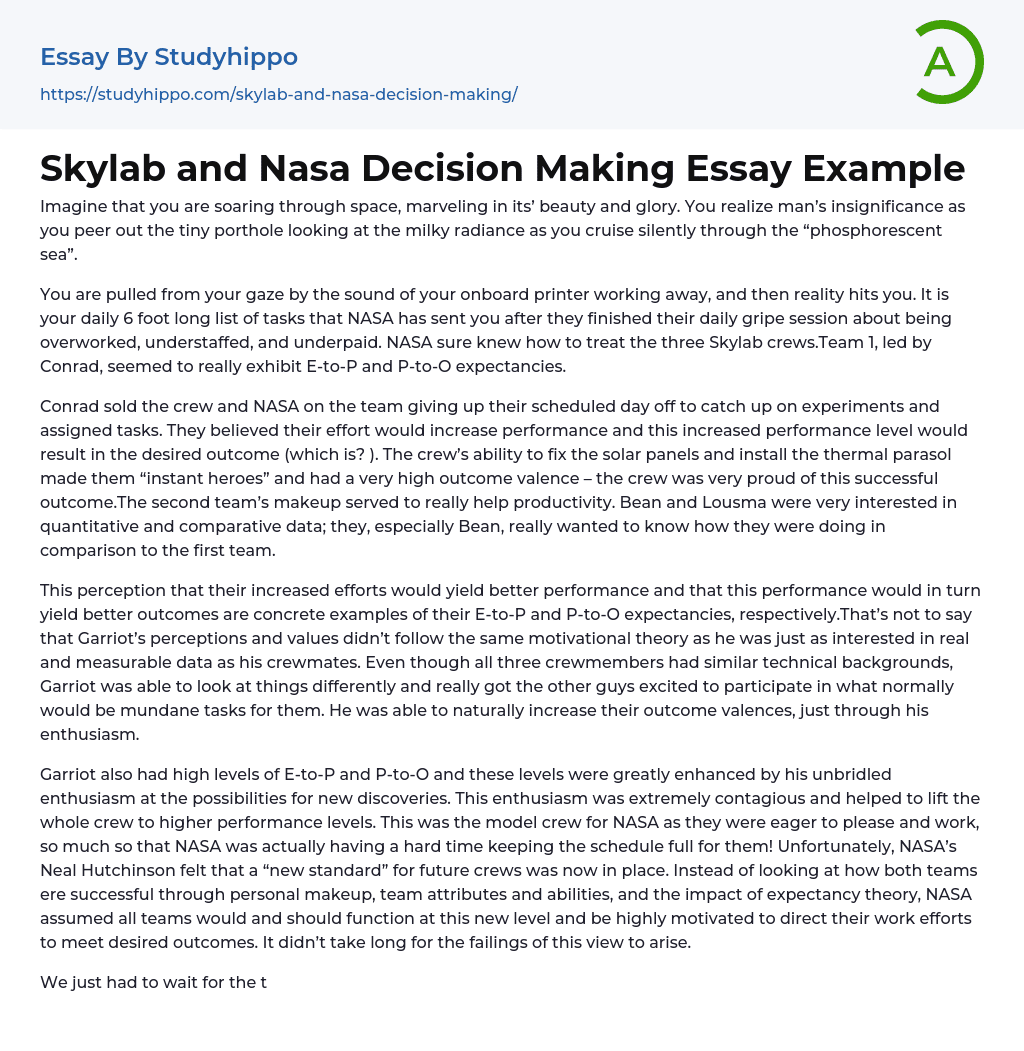As you travel through the vast expanse of space, admiring its magnificent beauty, you come to the realization of humanity's smallness. Gazing through the small window, you behold the splendor of the Milky Way, sailing quietly through the glowing cosmos.
As you gaze off, you're abruptly interrupted by the sound of your onboard printer churning out NASA's list of daily tasks. Being overworked, understaffed, and underpaid appeared to be a common gripe among NASA's Skylab crews. Despite this, Team 1, led by Conrad, displayed high levels of E-to-P and P-to-O expectancies.
Conrad convinced both the crew and NASA to forgo their scheduled day off in order to catch up on experiments and assigned tasks. It was believed that this increased effort would lead to improved performance and ultimately result in a desired outcome (however, the nature of this outcome is unspecified). The crew's successful completio
...n of tasks such as fixing solar panels and installing a thermal parasol earned them a high outcome valence and the status of "instant heroes", bringing them great pride. The second team, consisting of Bean and Lousma, was particularly interested in quantitative and comparative data, with Bean displaying a strong desire to gauge their performance against that of the first team, ultimately contributing to increased productivity.
The concrete examples of their E-to-P and P-to-O expectancies highlight the perception that increased efforts would result in better performance and this performance would bring better outcomes. Garriot's views and values aligned with motivational theory, and he sought real, measurable data like his crewmates. Despite having similar technical backgrounds, Garriot approached tasks differently, spurring enthusiasm in others and increasing their outcome valences naturally.
Garriot's
unbridled enthusiasm for discovering new possibilities contributed to elevated levels of E-to-P and P-to-O in his team. His contagious enthusiasm also helped to elevate the performance levels of his entire crew, making them model crew for NASA. Their eagerness to work and please caused NASA to struggle to keep up with their schedules. Unfortunately, NASA's Neal Hutchinson viewed this as a "new standard" for future crews, ignoring the role of personal makeup, team attributes, and abilities, as well as the impact of expectancy theory. This assumption that all teams could and should function at this level and be highly motivated to meet desired outcomes proved to be flawed. It did not take long for the limitations of this approach to become apparent.
We had to wait for the third and final Skylab crew to arrive while NASA had previously neglected to define the mission length, causing possible disagreements among the crew. NASA was aware of personality issues that could potentially cause problems, including the fact that none of the crew had been to space before, they had no personal connections with previous crews, and Skylab 3's science pilot, Gibson, was known for being difficult. Despite this, NASA criticized the crew publicly for not reporting Pogue's vomiting, creating conflicting outcomes.
The third crew during their time in space developed an "us against them" mentality which was fueled by various causes such as a cut in exercise time, scheduling of experiments during meal times, poor toilet facilities, and other numerous issues. These circumstances resulted in regular occurrences of rebellion. The third crew had little to no expectation of any positive outcome to their efforts or performance, with
both E-to-P and P-to-O expectations being low. Dissatisfaction with possible outcomes was also expected. Hence, they believed that NASA's task had very little value. To avoid such situations for extended stays, a team makeup that is a mix of both experienced and newbies with metric-driven members as well as those that enjoy the experience beyond quantitative measurement should be considered (ala Garriot).
In case there is not enough time between flights, it would be advisable to involve previous crews who have undertaken similar missions in collaboration with NASA and the next flight team, to develop the schedule. This approach will provide equal representation and ensure an agreement from all parties involved thereby eradicating the secrecy and hidden intentions that undermined Skylab projects. Furthermore, previous teams should be present at mission control during the event to observe and give feedback.
Include former astronauts in the teams responsible for the design of future space stations and vehicles. This concept has already been put into practice as Carr and Pogue, who were part of the Skylab 3 crew, assisted NASA in the creation of the current International Space Station (ISS) three decades later. They allocated a particular section for themselves, which was dedicated to educating others on how not to design a space station.
- Incentive essays
- Accident essays
- Awareness essays
- Benefits of Volunteering essays
- Challenges essays
- Childhood Memories essays
- Decision essays
- Driving essays
- Event essays
- Excellence essays
- Expectations essays
- Failure essays
- Farewell essays
- Flight essays
- Gift essays
- Growing Up essays
- Ignorance essays
- Improve essays
- Incident essays
- Knowledge essays
- Luck essays
- Memories essays
- Mistake essays
- Obstacles essays
- Overcoming Challenges essays
- Party essays
- Peace Corps essays
- Personal Experience essays
- Problems essays
- Sacrifices essays
- Struggle essays
- Success essays
- Trust essays
- Vacation essays
- Visit essays
- Volunteering essays
- Board Of Directors essays
- Brand Management essays
- Business Ethics essays
- Business Management essays
- Change Management essays
- Comparative Analysis essays
- Decision Making essays
- Dispute Resolution essays
- Knowledge Management essays
- Leadership essays
- Leadership and Management essays
- Manager essays
- Operations Management essays
- Performance Management essays




